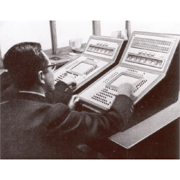Kinki Nippon Railway (Kintetsu) and NEC began designing and developing a seat reservation system at the end of 1958. The system went into operation in April 1960. The system allowed ticket counters at 20 train stations and travel agencies at other locations to check availability, sell tickets, and refund tickets up to five days in advance for as many as 80 inbound and outbound trains. The system could complete each operation in about three seconds, which was an astounding speed compared to the previous method of prearranged ticket quotas and telephone reservations.
The entire system was designed with emphasis on reliability and maintainability. Each terminal, circuit, and central device underwent looped isolation tests and operating margin tests. Dedicated phones were installed alongside the system as a means of communicating between terminals.
As the photo below indicates, the terminals consisted of a controller using a set of keys, relays, and transistors. All terminals communicated with the central unit with a carrier telegraphy method over one telephone circuit in a micro-trunk line owned by Kintetsu. The central unit consisted of a central processing unit and a magnetic drum memory unit. The central processing unit was a dedicated system with its reservation program hardwired with logic circuits. The unit featured redundant counters and control circuits, and logical operations used a parity bit. Its logic elements were based on the package used in the NEAC-2203. These logic elements detected errors with read-after-write checks of the magnetic drum and would repeat operations until the checks came back correct.
The magnetic drum memory unit developed specifically for the system had a capacity of one million bits, the largest drum capacity at the time. The system had two drums that maintained identical data records. Reads and writes of both drums were compared with each other as a correlation check. There was also a copy function to move from single operation to redundant operation.
As described above, the system had a whole range of functions for reservation operations, management, and maintenance. Although the developers learned many valuable lessons for online systems through the development and operation of this system, its wired program made it nearly impossible to update or extend the system’s functionality after it was built. Consequently, the next system NEC would build for Japan Air Lines was based on the NEAC-2230 and its stored program methodology.


